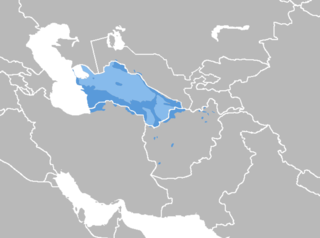
Back Аҭурқмен бызшәа Abkhazian Turkmeens Afrikaans ቱርክመንኛ Amharic तुर्कमेन भाषा ANP اللغة التركمانية Arabic لغه تركمانيه ARZ Idioma turcomanu AST Turkmenava AVK Türkmən dili Azerbaijani تورکمن تورکجهسی AZB
| Turkmen | |
|---|---|
| türkmençe, türkmen dili, түркменче, түркмен дили, تۆرکمن ديلی ,تۆرکمنچه | |
 Turkmen in the Latin, Cyrillic, and Perso-Arabic Alphabets | |
| Native to | Turkmenistan, Russia, Iran, Uzbekistan, Afghanistan, Tajikistan[1][2] |
| Ethnicity | 5.1 million Turkmens in Turkmenistan (2020)[3] |
Native speakers | 5.30 million (2021)[3] |
| Dialects | |
| Latin (Turkmen alphabet, official in Turkmenistan), Perso-Arabic, Cyrillic Turkmen Braille | |
| Official status | |
Official language in | Turkmenistan |
| Language codes | |
| ISO 639-1 | tk |
| ISO 639-2 | tuk |
| ISO 639-3 | tuk |
| Glottolog | turk1304 |
| Linguasphere | Part of 44-AAB-a |
 The distribution of the Turkmen language in Central Asia | |
Turkmen (türkmençe, түркменче, تۆرکمنچه, [tʏɾkmøntʃø][4] or türkmen dili, түркмен дили, تۆرکمن ديلی, [tʏɾkmøn dɪlɪ])[5] is a Turkic language of the Oghuz branch spoken by the Turkmens of Central Asia. It has an estimated 4.3 million native speakers in Turkmenistan (where it is the official language),[6] and a further 719,000 speakers in northeastern Iran[7] and 1.5 million people in northwestern Afghanistan,[8] where it has no official status. Turkmen is also spoken to lesser varying degrees in Turkmen communities of Uzbekistan and Tajikistan and by diaspora communities, primarily in Turkey and Russia.[9][10]
Turkmen is a member of the Oghuz branch of the Turkic languages. It is closely related to Azerbaijani, Crimean Tatar, Gagauz, Qashqai, and Turkish, sharing varying degrees of mutual intelligibility with each of those languages.[11] However, the closest relative of Turkmen is considered Khorasani Turkic, spoken in northeastern regions of Iran and with which it shares the eastern subbranch of Oghuz languages, as well as Khorazm, the Oghuz dialect of Uzbek spoken mainly in Khorezm along the Turkmenistan border.[12] Elsewhere in Iran, the Turkmen language comes second after the Azerbaijani language in terms of the number of speakers of Turkic languages of Iran.[13]
The standardized form of Turkmen (spoken in Turkmenistan) is based on the Teke dialect, while Iranian Turkmen use mostly the Yomud dialect, and Afghan Turkmen use the Ersary variety.[14] The Turkmen language, unlike other languages of the Oghuz branch, preserved most of the unique and archaic features of the language spoken by the early Oghuz Turks, including phonemic vowel length.[15]
Iraqi and Syrian "Turkmen" speak dialects that form a continuum between Turkish and Azerbaijani, in both cases heavily influenced by Arabic and Persian. These varieties are not Turkmen in the sense of this article.
- ^ Ethnic composition, language and citizenship of the population of the Republic of Tajikistan, Volume III (in Russian)
- ^ "Ethnic Turkmen of Tajikistan Preserve Traditions of Their Ancestors". CABAR.asia. 14 June 2019. Retrieved 7 January 2024.
- ^ a b Turkmen at Ethnologue (26th ed., 2023)

- ^ Clark, Larry (1998). Turkmen Reference Grammar. Wiesbaden: Harrassowitz Verlag. p. 527.
- ^ Clark, Larry (1998). Turkmen Reference Grammar. Wiesbaden: Harrassowitz Verlag. p. 521.
- ^ "Turkmen". Ethnologue. Retrieved 27 November 2023.
- ^ "Iran". Ethnologue.
- ^ Turkmen language at Ethnologue (18th ed., 2015) (subscription required)
- ^ "Where and how do the Turkmens abroad live? (in Russian)". Information Portal of Turkmenistan.
- ^ "Turkmen". Ethnologue. Retrieved 16 July 2022.
- ^ Sinor, Denis (1969). Inner Asia. History-Civilization-Languages. A syllabus. Bloomington. pp. 71–96. ISBN 0-87750-081-9.
- ^ Brown, Keith (2010). Concise Encyclopedia of Languages of the World. Elsevier. p. 1117. ISBN 978-0-080-87775-4.
- ^ "TURKMENS OF PERSIA ii. LANGUAGE". Encyclopedia Iranica.
- ^ "Who are the Turkmen and where do they live?". Center for Languages of the Central Asian Region. Bloomington, Indiana: Indiana University Bloomington. 2021 [2020]. Archived from the original on 3 June 2020. Retrieved 24 August 2021.
- ^ "Turkmens of Persia. Language". Encyclopedia Iranica.